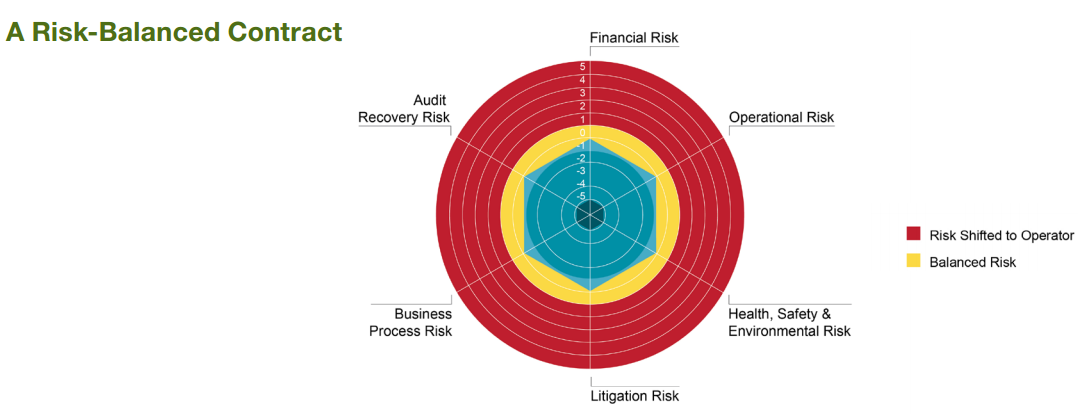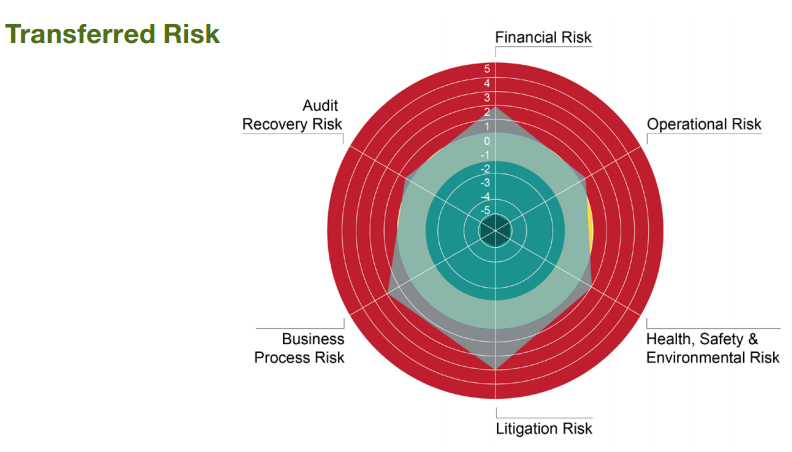
Utilizing Contract Language
Risk Assessment to Identify and
Minimize Operator Risk
A contract is a risk management document that governs the relationship between buyers and sellers and determines what risks each party has assumed under the terms of the contract. Well-written Contract Templates and Master Service Agreements (MSA) are strong risk management tools to govern that relationship. From our work conducting hundreds of Contract Language Risk Assessments (CLRA), we have identified that companies that move to standardized Contract Templates and MSAs have substantially less contracting risk than companies that do not. The ideal contract risk profile results in an equal sharing of risk in each of six areas, as shown below.

A composite of standard Contract Template risk profiles across the sector of companies with established Contract Templates and MSAs revealed that the operating companies – for business reasons – had taken on more risk than would be ideal. Some causes were:
•Right to Audit clause does not include/feature best practice language
•Definition(s) of costs are vague and subject to broad interpretation
•Lack of clear delineation of each party's responsibilities in several key sections of the Contract Templates and MSAs
More significantly, when the releases of Scopes of Work (SOW) or Purchase Orders (PO) against these Contract Templates and MSAs are factored in, the exposure of operating companies increases to an even greater level.
A transfer of risk occurs every time a Contract, Purchase Order or Release against a Contract Template or Master Service Agreement is issued.
Contract Releases and Master Contract Documents
The safeguards established in Contract Templates and MSAs can be negated by a poorly- written release. The composite risk profile shifts significantly when release documents are included in a CLRA, as shown in the chart below. The SOW or PO release against a standard Contract Template or MSA greatly increases operators' exposure, due to transferred risk which can be found in those documents.

We've identified these primary causes of risk transfer:
•Documents used to release the work incorporate terms and conditions which differ from, or are in direct conflict with, those in the Contract Template or MSA
•Contractors substitute their own pricing documents, effectively changing the contract pricing structure from that of the Contract Template or MSA
•Contractors take exception in the release documents to the Contract Template or MSA terms and conditions that were originally accepted
•Based on contractual hierarchy, risk is also transferred in contractual docu- ments such as releases, RFQ responses, additional work proposals, PO's, etc.
A transfer of risk occurs every time a Contract, Purchase Order or Release against a
Contract Template or MSA is issued. Not knowing if the terms and conditions of your standard Contract Templates were abrogated through a release document can have a serious impact on the finances and operations of your enterprise.
Only through periodic risk assessments can you clearly identify your company's risk level and close the gaps that expose you to increased risk.
Revenew's Performance Improvement services produce hard-dollar results for our clients — specific, tangible and often quite substantial. Please contact us today at
281-276-4500 or info@revenew.net to learn more. You have everything to gain.
www.revenew.net




